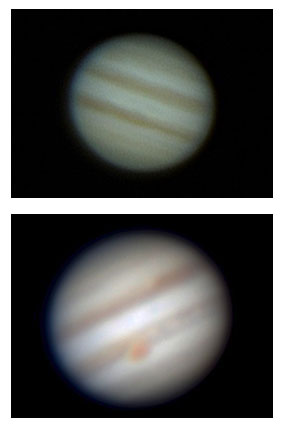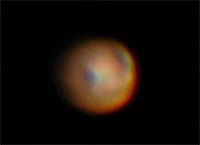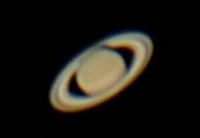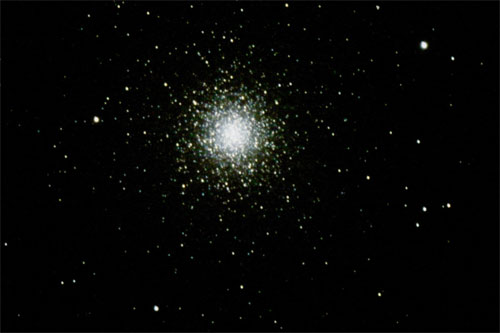Reprinted from the Island Free Press
April will start with Jupiter (magnitude -2.6) well above the eastern horizon at sunset. You should be able to spot it just after sundown. If you view it with a pair of binoculars or a telescope, you should be able to see its bands. On a good night, you might spot several of its larger moons. Jupiter will be visible for most of the night, setting in the west just before dawn.
Supporter Spotlight
Mars will rise around 11:40 p.m., followed by Saturn at 12:24 a.m. The two planets and the red star, Antares, will form a triangle that will move across the night sky throughout April. If you are having trouble distinguishing Mars and Antares, remember that Mars is the brighter of the two red objects–and it appears a little higher in the skies than Antares.
Pluto rose at about 2:30 a.m. on the morning of April 2. Neptune will rise at 5:40 a.m., just before dawn. With visual magnitudes of +14 and +8, neither will be visible to the unaided eye.
Mercury will be very close to the western horizon at dusk. As April progresses, Mercury will set a little later each night, so your chances of seeing it increase each evening. It will be at its highest point above the horizon on the evening of April 18. At this point, Mercury will be at its brightest, with a visual magnitude of +0.3. For the rest of the month, it will set a little closer to the horizon each night until it is lost in the glow of the sunset. Don’t look for Mercury before the sun has set. Even at dusk, the sun can be bright enough to cause eye damage.
The Lyrid meteor shower will peak on the night of April 22. The Lyrids usually offer about 10 to 20 shooting stars an hour, but sometimes you might see a fireball or two. The best viewing times will be after 10 p.m. on Friday. The full moon will make conditions less than ideal. The Lyrids seem to originate from the constellation Lyra. The prominent star in that constellation is Vega. You can find it by looking for the very bright star in the north-northeast.
Orion (the hunter) starts April as the most prominent constellation in the southwestern evening skies. But don’t overlook the Pleiades (M45). M45 will be between Orion and the horizon. It is often called the Seven Sisters because most people can easily make out five to seven of its stars with the unaided eye. If you look at it with binoculars, you will see much more. There are literally hundreds of stars in the Pleiades and lots of bright swirls of nebulosity.
Supporter Spotlight
Arcturus rises just after sunset in the northeast. It’s a bright double star that happens to be the brightest star in the northern hemisphere. It’s also very close to us – only 37 light years away. Its light was used to open the 1933 World’s Fair in Chicago. At that time, measurements put Arcturus 40 light years away. Chicago had hosted the 1893 World’s Fair, so it seemed fitting to open the 1933 World’s Fair with starlight that had started its journey to Earth during the previous event. This was accomplished by using several telescopes to collect the light of Arcturus, focus it on solar cells, and then use it to switch on the current for the floodlights of the fair.
March Highlights

In my last article, I presented this image of Jupiter, left, and told you this is a work in progress.
I think I made a little progress. On March 1, I started using a Canon DSLR camera for planetary imaging. This branch of astrophotography is very different than the approach I use for “deep space objects” like galaxies and nebula. The planets and moon are all relatively bright objects, so instead of taking multiple long exposure images, I’ve been using the DSLR as a high-quality video camera. The procedure consists of focusing on the planet, capturing a sequence of 500 to 2,000 frames, and then processing the frames with special software that selects the best 200 or 300, aligns them, and then helps pick out the details.
In theory, it sounds pretty simple, but it gets difficult real fast. Atmospheric conditions are a major obstacle. At times, Jupiter was jumping around so fast on the monitor I could only guess at the right focus.

Here are a couple of shots, right, that showed major improvements over last month’s image. I included both because the second one shows the famous red spot of Jupiter. That’s a massive storm that’s been observed for the past 300 years.
Jupiter is the fifth planet from the sun. It’s roughly 420 million miles from Earth and has a visual magnitude of -2.4. With a diameter of 88,846 miles, Jupiter is more than 11 times larger than Earth. It takes Jupiter 11.86 years to orbit the sun, and the planet has 67 moons.
I also got fairly good shots of Mars, top, and Saturn.

Mars is the fourth planet from the sun. Mars takes 687 days to orbit the sun. Mars’ closest approach to the Earth is about 22 million miles. Its furthest distance from Earth is close to 155 million miles. Because of its small size — 4,220 miles, about half the diameter of Earth — the magnitude of Mars varies from -2.9 to +1.7. Mars will be at its closest approach to Earth in the beginning of May. It has two moons.

Saturn is the sixth planet from the sun. It’s about 893 million miles from Earth with a visual magnitude of +0.3. Saturn’s diameter is 74,897 miles which is about nine times that of the Earth. Saturn takes 29.4 years to orbit the sun. It has 62 moons.
I didn’t entirely abandon deep space object photography either. I also got this nice image of M3, which is a globular cluster in the constellation Canes Venatici. With a visual magnitude of +6.2, it is not visible to the naked eye! M3 is about 33,000 light years away.

Moon Phases
New moon: April 7
First Quarter: April 13
Full moon: April 22
Last Quarter: April 29
Astronomy Talk
DSLR is an acronym for digital single lens reflex camera. All of the images in this month’s article were taken using a Canon T5 DSLR mounted on my Celestron telescope. I had to purchase a special adapter called a T-ring to mount the camera on the telescope. Once you have the camera on the scope, focusing and operating the shutter become major issues. Luckily, there is good cheap software available that can help solve both issues.
This story is provided courtesy of the Island Free Press, a digital newspaper covering Hatteras and Ocracoke islands. Coastal Review Online is partnering with the Free Press to provide readers with more environmental and lifestyle stories of interest along our coast. You can read other stories about Hatteras and Ocracoke here.







